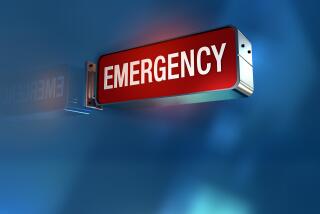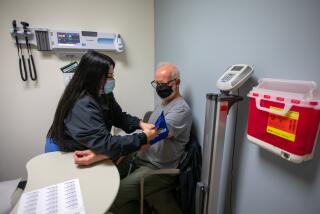Why you should be skeptical about an ‘Uber for healthcare’
- Share via
The worst aspect of the “Uberization” of our economy may not be the transformation of workers who could once earn a living wage into “independent contractors” who can barely make ends meet (though that’s bad enough); it may be the spreading myth that any economic function can be shoehorned into the Uber format of service-on-demand at a rock-bottom price.
A case in point is the mirage of an “Uber for healthcare.” The latest and most prominent promoter of this notion is the conservative healthcare analyst Avik Roy of the Manhattan Institute. In a new issue brief he poses the question directly: “Why isn’t there an Uber of health care?” he asks. “Why can’t we deploy, in health care, the same forces that are improving quality and lowering costs in virtually every other sector of the economy?”
Short of teleportation, the doctor house call will always be an irresponsibly massive reduction in primary care efficiency.
— Jay Parkinson, MD, CEO of Sherpaa
Millions of dollars in venture funding have already been deployed to answer Roy’s question with a “Why not, indeed?” Pager, a mobile app company that arranges doctor house calls in New York and San Francisco, has attracted more than $24 million in early-round investment; Heal provides a similar service in the Los Angeles, San Francisco, and San Diego regions. But both have limitations that point to real difficulties in applying the Uber idea to healthcare. In fact, there are indications that the model makes healthcare less efficient.
Let’s dismiss right off Roy’s assertion that Uber necessarily has improved the quality or lowered the costs of transportation, much less any other service. Although Uber may have made local transportation more available in some places and some times of day, there’s no evidence that its drivers are better, or safer, than taxi drivers, and some evidence that the form does less than taxi fleet owners or regulators to ensure the safety and quality of the person behind the wheel or the vehicle being driven.
As for lowering the costs, tell that to someone blindsided with a surge price for a ride late at night or in a high-demand period. And that’s the price, not the cost--for the latter, one has to factor in the cost to the driver of providing the service net of expenses, which in many cases can reduce the driver’s take to minimum wage or less.
The real question is whether healthcare harbors the same inefficiencies that Uber has exploited. That involves the question of whether healthcare is a service that can be reduced to fundamentals like local transportation. Is diagnosing or treating a disease the same thing as driving a car?
Indications are that the answer is no.
From the patient’s standpoint, services like Heal and Pager aren’t especially cheap compared with, say, an insurance co-pay for an office visit. Pager doesn’t accept insurance, so a patient summoning a medical professional to a home via Pager’s app will pay $200 per visit (after a first-visit come-on fee of $50). Heal accepts some Blue Shield and Anthem Blue Cross coverage; everyone else pays $99. Lab tests are extra. Some services don’t always dispatch a doctor; sometimes it’s a nurse practitioner.
The range of what these professionals can offer at the home is necessarily limited. You’re not going to arrange a Pager or Heal appointment for anything that looks like, say, a cardiac event. Kidney stone with a pain rating of 10 out of 10? You want to be at the hospital.
The services are more suited for diagnosis and treatment of minor complaints that might require first aid, like sprains and minor burns, or stomach aches, routine blood tests, or simple physicals for “camp, school and employment,” as Pager says. Heal lists colds, ear infections, and headaches as indications for which you might summon a visit.
Some of these ailments may not require any professional treatment at all, which means that the services are encouraging more consumption of healthcare when sitting tight and waiting for the problem to resolve itself might be the right move. Pager and Heal both push “health assessments,” which could involve blood tests or other diagnostic efforts for no particular reason at all. That’s the sort of casual, wasteful consumption of healthcare that many experts say we should be moving away from.
Then there’s the issue of whether these services are the best use of professionals’ time. Doctors and nurse practitioners are not as thick on the ground as are people who think they’re qualified to spend a couple of hours a day driving others around. Few of them may be willing to undergo the rigors of itinerant patient visits, especially if the equipment and medicines they need are located in a central place, like their office.
Consider the experience of one who knows. In 2007, Jay Parkinson, a young Penn State- and Johns Hopkins-trained physician, started an Uber-like house-call service on his own in Brooklyn. “My idea was perfect for the promise of the mobile Internet,” he wrote in December on the website KevinMD.com. Patients could visit his website, click on an embedded Google Calendar and make an appointment. He got mentioned on MSNBC, CBS, NPR, and elsewhere, and soon his calendar was filled to the brim with patients in his small service area, at $100 per visit (no insurance).
He had fun, but soon got burned out physically and psychologically: “I’d wake up and hope that I got a few early appointments during the night. I’d read their stories and then email them to arrange the house call. If I needed to draw blood, I’d ensure the right supplies were in my doctor bag. If I needed vaccines, I’d have to swing by the pharmacy to pick up the vaccine. If I had to draw blood, I’d have to drop that off to be picked up.”
Parkinson realized that more than half his time was spent on logistics and traveling between appointments, a huge suck of time he needed to spend actually seeing patients. “Short of teleportation, the doctor house call will always be an irresponsibly massive reduction in primary care efficiency.... Traditional primary care doctors can see 30 or so patients a day in their offices. House call doctors can see seven to eight. Even with a 20% increase in house call efficiency, house call doctors could see a maximum of 10 patients a day.”
Parkinson eventually give up his house-call practice to launch Sherpaa, a service marketed to companies that arranges preliminary diagnoses for their employees, advising remotely whether they should see a doctor and, if so, arranging office appointments.
The app-enabled house call at even $100 will soon disappear, he predicts. “They’ll be more like $499 or $599. And a shockingly small number of consumers will pay that amount for their pink eye. For example, it’s about the same amount of people willing to spend $499 on a cab to JFK. Also, zero health insurers will reimburse $499 for pink eye treatment.”
The “Uber for healthcare,” in other words, will be a rich person’s plaything.
That doesn’t mean that massive inefficiencies can’t be wrung out of the American healthcare system. Indeed, some payment paradigms being tested under the Affordable Care Act aim to do just that, by discouraging payment by test, moving toward payment by outcome, and giving hospitals incentives to reduce readmissions.
Much of the talk of an “Uber for healthcare” comes from people, like Roy, who think the free market is the answer to everything--let doctors work when they want, on who they want, without any interference from government or insurance companies, then all the complexities of medical care will fall away. Everyone will make more money while the patients pay less.
The truth is that no one even knows yet if Uber’s model is a profitable one for Uber itself. For a capital- and knowledge-intensive sector like healthcare, in which a missed or mistaken diagnosis can mean injury or death, the idea that an app is the answer looks more like fantasy.
Keep up to date with Michael Hiltzik. Follow @hiltzikm on Twitter, see our Facebook page, or email michael.hiltzik@latimes.com.
More to Read
Inside the business of entertainment
The Wide Shot brings you news, analysis and insights on everything from streaming wars to production — and what it all means for the future.
You may occasionally receive promotional content from the Los Angeles Times.











